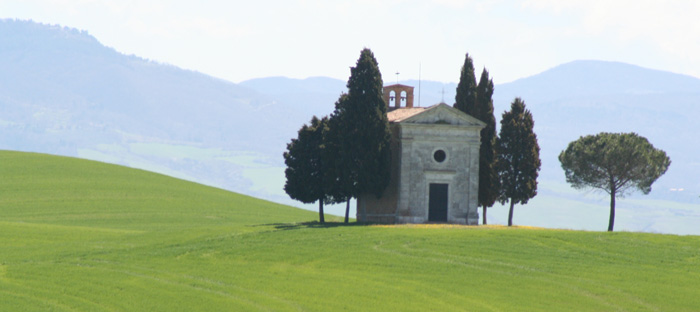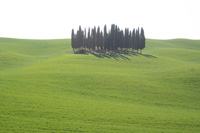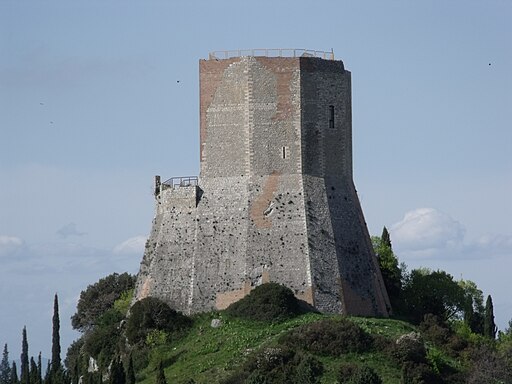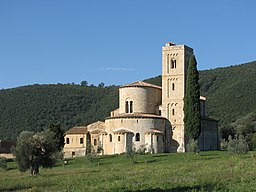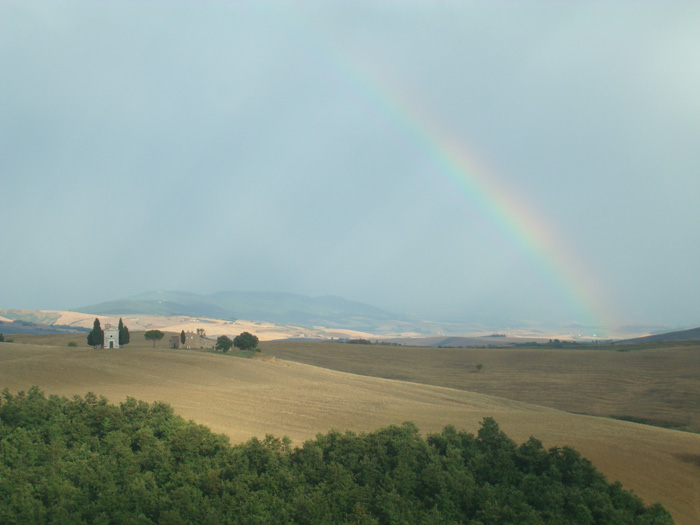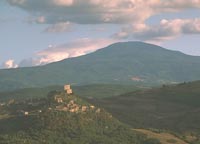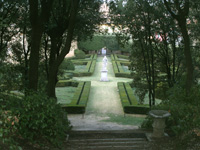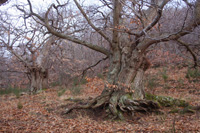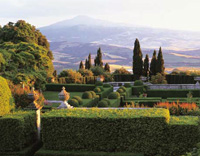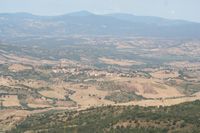Pienza is situated on the Via Cassia, just a few kilometers from Cianciano Terme, one finds Pienza. Like Castiglione d'Orcia, Montalcino, Radicofoni and San Quirico d'Orcia the city is part of the Val d'Orcia.
Pienza is known for its historical ties with Enea Silvio Piccolomini, who became Pope Pio II in 1458 and transformed Pienza from a small Medieval village into an elegant Papal residence with architecture typical of the Renaissance period.
Even the shortest of visits to Pienza should include a walk along the town walls and an exploration of the historic center, with its perfectly preserved Renaissance buildings, such as Palazzo del Tesoriere, Palazzo Lolli, the Cathedral of the Assunta, Palazzo Piccolomini, Palazzo Borgia and Joffroy, Palazzo Comunale, Palazzo Ammanati, the Parish Church of Corsignano. Local delicacies include the Cacio pecorino cheese which can be tasted and bought in almost all of the shops in the town.
San Quirico d'Orcia is situated atop a hill within the Valdorcia Nature Park, in an area of Tuscany which comprises the towns of Bagno Vignoni, Montalcino, Pienza, and Montepulciano. The origins of this ancient town date back to the Etruscan period. Around about the year 1000, San Quirico established itself as important town on the via Franchigena, the road linking Canterbury with Rome. It was in San Quirico d'Orcia that Fredrick I the 1st met with the pontifical authorities after his arrival in Italy to receive the imperial crown in 1154. In 1552 the troops faithful to Charles V chose San Quirico d'Orcia as military outpost from where to control the entire valley.
An imposing perimeter wall protects the town, accessed by a gateway, the only of the four original gateways to have survived the passage of time. The historic center of San Quirico perfectly conserves its medieval plan and a great number of impressive works of architecture such as the Romanesque Church of the Collegiata, with its three portals one of which attributed to Giovanni Pisano; the 17th century Palazzo Chigi; the Church of San Francesco which houses a Madonna by Andrea della Robbia; the Horti Leonini, splendid example of late 16th century landscape gardening; the intimate Romanesque Church of Santa Maria dell'Assunta and the Ospedale della Scala, once the refuge of pilgrims travelling along the via Franchigena.
Cinigiano is definitely one of the most fascinating and enchanting location of Alta Maremma, seen as a small but wonderful ancient village, with panoramas capable of taking away the breath and capturing the attention of the observer.
Immersed amongst the fascinating scenery of Monte Amiata, between splendid forests of beeches, oaks and chestnuts, with an immensely beautiful and stupendous panorama; is the town Cinigiano.
A wonderful centre in the province of Grosseto, the town offers a view of the rolling hills, plains and valleys that are absolutely splendid and rich in olive trees and vines; which give the area a magical and enchanting feeling.
The town is truly a wonderful gem of art and ancient culture, with an extraordinary richness of monuments, churches and historical palazzi, which will definitely fascinate and inspire visitors with their beauty and the wonderful works of art, paintings and frescoes which adorn them.
Of the history of Cinigiano, we know that the town was born sometime in the 1100’s, when the original inside settlement and medieval fortress were established. In subsequent centuries, the town became part of the possessions of the Aldobrandeschi family of Santa Fiora, before passing under the control of the powerful Republic of Siena in the second half of the 13th century.
During the next centuries, the town was controlled by some of the local noble houses, including the Battifolle family and Pioppi family.
Cinigiano then became part of the Grand Duchy of Tuscany with the important Grand Duke Pietro Leopolo. Finally in the 1860’s the Maremman town was annexed by the Kingdom of Italy.
The town of Campagnatico boasts great importance and secular relevance and was even mentioned in Dante’s fable The Divine Comedy, in the 11th canto of Purgatorio (Purgatory), which refers to the character of Umberto Aldobrandeschi. The origins of the city of Campagnatico began under the dominion of the Abbey of San Salvatore, before falling under the control of the Aldobrandeschi family, who managed to maintain power from the end of the 10th century to the end of 1259. This was the year, as mentioned by Dante in The Divine Comedy, that Umberto Aldobrandeschi was assassinated and the dominion of Campagnatico passed into the hands of the Republic of Siena. The town then spent some time under the Grand Duchy of Tuscany before finally being annexed by the Kingdom of Italy.
Villa La Foce is a re-created renaissance style garden designed by Cecil Pinsent between 1927 and 1939 for Iris Origo, a writer and horticulturalist.
Villa La Foce was originally built at the end of the XVth century as a wayside tavern, but soon became the centre of an estate belonging to the great Hospital of Santa Maria della Scala in Siena. In 1924 it was bought by Antonio and Iris Origo and turned into their comfortable home, from where they farmed and developed the land.
The Villa is built on three levels, following the lie of the hill, and is surrounded by the now famous garden created by Iris Origo and the English architect Cecil Pinsent – a ‘labour of love’ lasting many years.
When Antonio and Iris Origo bought the estate of La Foce, they engaged the English architect Cecil Pinsent, who had previously done extensive work on Bernard Berenson's Villa I Tatti in Florence, to restructure the main buildings and create a large garden. The latter was conceived to enhance the Renaissance house and expand the spectacular view over the valley of the Orcia and the Amiata mountain. The harmony between buildings, garden and nature makes La Foce an ideal example of Tuscany's architectural and cultural evolution in the XXth century.
The garden grew gradually, between 1925 and 1939. The house is surrounded by a formal Italian garden, which is divided into geometrical ‘rooms’ by box hedges with lemon trees in terracotta pots. Travertine stairs lead to the rose garden and a winding wisteria-covered pergola bordered by lavender hedge. Gentle informal terraces climb up the hill, where cherry trees, pines and cypresses grow among wild broom, thyme and rosemary, and a long cypress avenue leads to a 17th-century stone statue. Through the wood, a path joins the garden and the family cemetery, considered one of Pinsent's best creations.
Opening hours: the garden is open to the public every Wednesday afternoon (all year around) and every first weekend of the month (from April to November).
Gardens in Tuscany | Villa La Foce
Villa La Foce Estate | La Foce - 61, Strada della Vittoria -53042 Chianciano Terme - Siena | www.lafoce.com

Walking in Tuscany | Walking in the Val d'Orcia
The territory of the Val d'Orcia is made up, mainly of a hilly landscape with gently rolling hills and valleys typical of the Sienese Crete and a rich variety of vegetation. The river Orcia springs from a gorge and winds its way across the valley.
North west of Bagno Vignoni a magnificent rocky gorge covered with woodlands and Mediterranean maquis opens out onto the vineyards of Montalcino and then continues to the sea. On the slopes of Monte Amiata are forests of beech and chestnut trees and of particular interest and rare beauty is the holm oak woods of Scarceta. The Abetina del Vivo with ancient silver fir trees is situated near the old village of Vivo d'Orcia famous for its springs which provide water for much of the area.
the ancient roads of Val d’Orcia offer a great variety of itineraries. Wine lovers can go up to Montalcino through the Brunello vineyards. Those who prefer panoramic views can follow the ridge between Radicofani and Contignano, opposite Amiata. The pathway of the Orcia gorges offers Mediterranean atmospheres and flora.
The one that passes through the Orcia gorges from Bagno Vignoni leads to Ripa d’Orcia, a 20th century reconstruction of a fort that belonged to the Salimbeni and Piccolomini families. Ripa and its view of Amiata can also be reached from San Quirico by a dirt road that passes by the village and the tower of Vignoni. Going up from Castiglione d’Orcia to the Vivo you are immersed in the volcano forests. Between Monticchiello and Pienza, or around Sant’Anna in Camprena, you can enjoy the undulating outlines of hills that seem to pile up into infinity.
|
